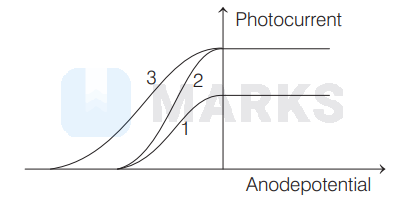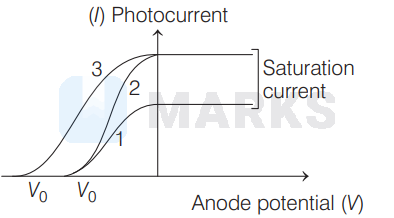Search any question & find its solution
Question:
Answered & Verified by Expert
The following graph represents the variation of photocurrent with anode potential for a metal surface. Here $I_{1}, I_{2}$ and $I_{3}$ represents intensities and $\gamma_{1}, \gamma_{2}, \gamma_{3}$ represent frequency for curves 1,2 and 3 respectively, then

Options:

Solution:
2149 Upvotes
Verified Answer
The correct answer is:
$\gamma_{1}=\gamma_{2}$ and $I_{1} \neq I_{2}$
The given figure can be shown as

From figure, we can see that the stopping potential $\left(V_{0}\right)$ is same for curve 1 and 2. But for curve 3 , it is greater than that for land 2 .
As, we know that, $e V_{0}=E_{\max }=h \gamma-\phi_{0}$
where, $\phi_{0}$ is the work function.
Since, $V_{0}$ is same for 1 and 2, so from above equation, we have $r_{1}=r_{2}$
Thus, for 1,2 and 3
$\gamma_{1}=\gamma_{2} \neq \gamma_{3}$
Also, the saturation current of curve 2 is greater than of curve 1 . But for curve 2 and 3 it is equal, so,
$I_{1} \neq I_{2}=I_{3}$

From figure, we can see that the stopping potential $\left(V_{0}\right)$ is same for curve 1 and 2. But for curve 3 , it is greater than that for land 2 .
As, we know that, $e V_{0}=E_{\max }=h \gamma-\phi_{0}$
where, $\phi_{0}$ is the work function.
Since, $V_{0}$ is same for 1 and 2, so from above equation, we have $r_{1}=r_{2}$
Thus, for 1,2 and 3
$\gamma_{1}=\gamma_{2} \neq \gamma_{3}$
Also, the saturation current of curve 2 is greater than of curve 1 . But for curve 2 and 3 it is equal, so,
$I_{1} \neq I_{2}=I_{3}$
Looking for more such questions to practice?
Download the MARKS App - The ultimate prep app for IIT JEE & NEET with chapter-wise PYQs, revision notes, formula sheets, custom tests & much more.